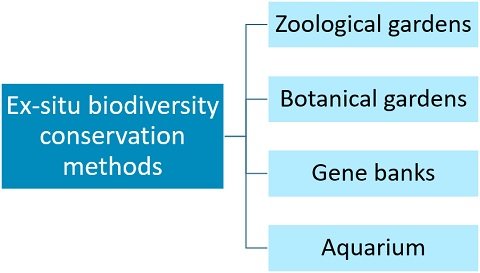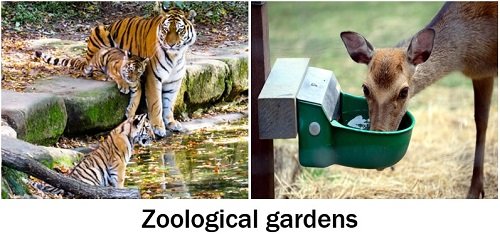Ex-situ biodiversity conservation refers to one of the approaches of conserving biodiversity that ensure the survival and sustainability of endangered plants and animal species outside their native habitat. It provides an artificial environment for diverse plants and animals similar to their actual growth conditions.
It is also termed as “Off-site conservation”. Human activities and some natural disasters are the factors responsible for the global decline in biodiversity. Thus, ex-situ conservation is one of the approaches to cope up with the consequences of declining biodiversity.
Ex-situ biodiversity conservation primarily targets endangered species, species with local importance, ethnobotanical interest and taxonomically isolated species. This post describes the definition, key points, methods, advantages and limitations of the ex-situ biodiversity conservation.
Content: Ex-Situ Biodiversity Conservation
Definition of Ex-Situ Biodiversity Conservation
It refers to the method of conserving genetic, species and ecosystem biodiversity by artificially providing habitats close to their natural environment. Zoological gardens, botanical gardens, aquariums and gene banks are ex-situ conservation methods.
It is the conservation of biodiversity outside a species’ natural geographical range. Besides conservation, it also ensures restoration and reintroduction of species by preserving the genetic and reproductive material of desired species that are about to extinct from the population.
Key Points
- It involves transferring threatened, endangered and extinct species away from their native environment.
- It targets plant and animal populations. Ex-situ conservation provides artificially created environments or conditions alike to their actual habitats to the plant and animal populations.
- It increases the genes, seeds, sperms, ovules etc. viability through cryopreservation.
- Survival of the threatened species is the primary approach of ex-situ conservation.
- It also targets the maintenance of genetic diversity.
- Ex-situ conservation of plants is mainly established to preserve seeds, pollens and ovules. Plant tissue culture and plant breeding are also part of ex-situ conservation, through which plants are produced in-vitro.
- Ex-situ conservation of animals is established to preserve semen, ova and DNA. Captive breeding and embryo culture are also the techniques that allow the reintroduction of the species.
- It conserves genetic resources, wild species and cultivated species.
- Knowledge of the genetic structure of target species, regeneration methods and maintenance of gene pool become necessary to establish ex-situ conservation.
Ex-situ Conservation Methods
Ex-situ biodiversity conservation includes the following methods:

Zoological Garden
‘Zoo’ or ‘Animal Park’ refers to the place that displays wild animals living in captivity (away from their natural environment). Zoological gardens provide food, shelter and medicine to a wide variety of animals and birds.
There are more than 164 zoos in India. Zoo provides a confined space to the animals through small cages, paddocks and fenced-in fields. Programmes on animal’s well-being, captive breeding, environmental education and exhibitions are also provided in the zoos.

Captive breeding provides an important tool to prevent the extinction of animal species. Its primary goal is to conserve the maximum genetic variability within species. Captive breeding reduces mating between closely related individuals in order to minimize inbreeding and loss of genetic variation.
- Curators in zoological gardens are exceptionally trained in the animal acquisition and transfer.
- Keepers perform routine check-ups of the animals.
- Veterinarians focus on preventive measures against contagious diseases, accidental injuries and autopsies.
- Trained volunteers guide visitors and also monitor their actions.
Botanical Garden
It displays a variety of rare and exotic plant species. The botanic garden provides an essential tool for education and research purposes. It allows the growth of flowers, fruits and vegetables by providing similar growth conditions and nutritional requirements.
Plantings are scientifically ordered based on their phylogeny and taxonomy. It also includes nurseries and greenhouses to propagate and cultivate exotic plants. It helps in studying the tropical and temperate ecosystem. The botanical garden maintains the sustainability of abandoned ornamental plants. A botanical garden conserves endangered and rare plant species. It looks aesthetic to the visitors.

Gene Bank
It functions as a biorepository. The Gene bank preserves the animal’s genetic material as well as plant’s structures with regeneration capacity. It involves the freezing of animal’s sperms and eggs in zoological freezers. It also freezes the plant’s cuttings and seed stocks.
Coral fragments can also be preserved in water tanks by providing a controlled environment. Thus, the gene bank serves as a centre for keeping genetic and reproductive material. It uses the cryopreservation method to store the reproductive and genetic content of plants and animals. Following are the types of gene banks:
- Seed Bank: It stores seeds to conserve genetic diversity. Seed banks or “Seed libraries” has a primary approach to increase yield, disease resistance and nutritional quality of plants. Here, cryopreservation preserves the seed’s viability for the long term. We can introduce genetically modified methods through seed banks.
- In-vitro bank: It involves the preservation of buds, meristematic cells and tissues in a semi-solid or liquid nutrient medium. It is a kind of slow growth conservation method used prevalently to conserve seedless plants.
- Cryobank: It preserves seed and embryo through cryopreservation at -196 degrees Celsius. Cryobank targets to conserve extinct species. It is also helpful for the preservation of animal genetic resources.
- Pollen bank: It stores the pollen grains in liquid nitrogen. Pollen bank plays a pivotal role in crossbreeding.
- Field gene bank: It is a method of planting plants in an artificially created environment. We can conserve the germplasm of essential plants through this method. It needs more land area, soil and is vulnerable to pests and diseases.
Aquarium
It seems like a vivarium that varies in size. Aquarium houses aquatic plants and animals. The plants in the aquarium give enough oxygen to water bodies within the aquarium. We can keep small aquariums at home. Large public aquariums house fishes, otters and turtles. Glass or acrylic typically frame the body of the aquarium.

Fish tanks are the cuboidal aquaria, and fish bowls are the oval or bowl-shaped aquaria. Aquarium requires high maintenance, and an aquarist must be skilled in operating the components of the aquarium. The filtration system, air diffuser, pump and thermostat are the components of an aquarium.
Advantages
- It requires less area.
- Threatened species are protected from all adverse factors like predation and poaching.
- Under human supervision, plant and animal health can be monitored, and medical assistance can be given as required.
- Any disaster and disease management becomes easy in the ex-situ biodiversity conservation, as it only conserves the small population.
- We could measure the genetic diversity of the population.
- We can conduct selective breeding programmes for the animals and plants to increase their numbers if endangered.
- It is also helpful for the educational purpose, as researchers and educators may study the reproductive physiology, lifestyle and ecology of endangered species up-close.
- Ex-situ collection sites could raise funds for conservation efforts.
Limitations
- Ex-situ biodiversity conservation is applicable to conserve the small population.
- It requires more expense to conserve the threatened plant and animal species, as they require special care and attention as well as basic needs like food, shelter and medicine.
- Ex-situ conservation involves several expensive methods like cryopreservation and tissue culture to preserve the genetic and reproductive material.
- It provides less mobility to the animal populations due to the restricted or small space.
- Animals are vulnerable to a wide range of diseases due to the translocation from their natural habitats.
- Animals may not survive reintroduction into the wild habitat, or they can face difficulties with acceptance by the existing wild species.
- Nutritional issues may arise.
Conclusion
Biodiversity conservation is necessary to maintain the ecological balance, continue natural processes and support the ecosystem. Ex-situ biodiversity conservation has a practical approach to protect rare and endangered species.